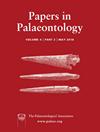中三叠世卡西亚型动物群(Pelsa-Vazzoler Lagerstätte)与现代进化动物群的适应性辐射
IF 2.3
2区 地球科学
Q1 PALEONTOLOGY
引用次数: 0
摘要
我们描述了来自阿戈多白云岩(意大利东北部)上拉迪南期的一个高多样性硅化海洋软体动物群(Pelsa-Vazzoler Lagerstätte)。有关二叠纪末大灭绝后三叠纪反弹的新数据将其限制在一个气候条件相对稳定的时期。斯基里亚地层中的这个拉格斯塔特,其结构可与著名的下卡尼安圣卡西亚诺拉格斯塔特相媲美,并表明底栖软体动物的辐射可能早在中三叠世晚期就已出现。我们对 4800 多种卡西亚型软体动物进行了分类,测量了 109 个物种的丰度分布,其中包括一个新科(Rhaetidiidae)、三个新属(Pelsia、Gaetania、Agordozyga)和 21 个新种:Grammatodon egortinus、Modiolus friesenbichlerae、Myoconcha busattae、Schizogonium letiziae、Predazzella?monarii、Eucycloscala nitida、Tricolnaticopsis elongatus、Cortinella stricta、Triadoskenea alpicornu、Trachynerita tenuicostata、Coelostylina civettae、Gaetania coronata、Agordozyga caprina、Euthystylus dincae、Zygopleura elongata、Diatrypesis agordina、Cryptaulax pelsae、Pseudoscalites karapunari、Promathildia gracile、Camponaxis ladinica 和 Striactaeonina ingens。在这个与热带碳酸盐平台有关的动物群中,上层滤食性双壳类动物采用了新的反捕食特征,腹足类动物征服了新的生态空间,包括在海绵和硬骨珊瑚上的寄生和微肉食。在由孤立的小块珊瑚礁组成的生态系统中,小体型是一种优势。这就是尾足类和异鳃蜗牛(今天主导全球海洋多样性的类群)在海洋底栖生物中开始崛起的方式、地点和时间。因此,一些对我们理解中生代海洋革命的时间和地点至关重要的进化创新的起源被推回到了中三叠世。本文章由计算机程序翻译,如有差异,请以英文原文为准。
A Middle Triassic Cassian‐type fauna (Pelsa‐Vazzoler Lagerstätte) and the adaptive radiation of the Modern evolutionary fauna
We describe a high‐diversity silicified assemblage of marine molluscs (Pelsa‐Vazzoler Lagerstätte) from the upper Ladinian of the Agordo Dolomites (northeastern Italy). New data on the Triassic rebound, after the end‐Permian mass extinction, constrain it to an interval of relatively stable climatic conditions. This Lagerstätte, in the Sciliar Formation, yields a structure comparable to the famous lower Carnian San Cassiano Lagerstätte and suggests that the radiation of benthic molluscs may have occurred as early as the late Middle Triassic. We classified more than 4800 Cassian‐type molluscs, measuring abundance distributions of 109 species, including one new family (Rhaetidiidae), three new genera (Pelsia , Gaetania , Agordozyga ) and 21 new species: Grammatodon egortinus , Modiolus friesenbichlerae , Myoconcha busattae , Schizogonium letiziae , Predazzella ? monarii , Eucycloscala nitida , Tricolnaticopsis elongatus , Cortinella stricta , Triadoskenea alpicornu , Trachynerita tenuicostata , Coelostylina civettae , Gaetania coronata , Agordozyga caprina , Euthystylus dincae , Zygopleura elongata , Diatrypesis agordina , Cryptaulax pelsae , Pseudoscalites karapunari , Promathildia gracile , Camponaxis ladinica and Striactaeonina ingens . In this fauna, associated with tropical carbonate platforms, epifaunal filter‐feeding bivalves adopted new antipredatory features and gastropods conquered new ecospace, including parasitism and microcarnivory on sponges and scleractinian corals. Small size was an advantage in an ecosystem of small, isolated patch reefs. This is how, where and when caenogastropod and heterobranch snails (groups that today dominate global marine diversity) began their rise in the marine benthos. The origins of some evolutionary innovations that are key to our understanding of the time and place of the Mesozoic Marine Revolution, are therefore pushed back to the Middle Triassic.
求助全文
通过发布文献求助,成功后即可免费获取论文全文。
去求助
来源期刊

Papers in Palaeontology
PALEONTOLOGY-
CiteScore
4.50
自引率
4.30%
发文量
55
期刊介绍:
Papers in Palaeontology is the successor to Special Papers in Palaeontology and a journal of the Palaeontological Association (www.palass.org). The journal is devoted to the publication of papers that document the diversity of past life and its distribution in time and space.
Papers in Palaeontology is devoted to the publication of papers that document the diversity of past life and its distribution in time and space. As a sister publication to Palaeontology its focus is on descriptive research, including the descriptions of new taxa, systematic revisions of higher taxa, detailed biostratigraphical and biogeographical documentation, and descriptions of floras and faunas from specific localities or regions. Most contributions are expected to be less than 30 pp long but longer contributions will be considered if the material merits it, including single topic parts.
The journal publishes a wide variety of papers on palaeontological topics covering:
palaeozoology,
palaeobotany,
systematic studies,
palaeoecology,
micropalaeontology,
palaeobiogeography,
functional morphology,
stratigraphy,
taxonomy,
taphonomy,
palaeoenvironmental reconstruction,
palaeoclimate analysis,
biomineralization studies.
 求助内容:
求助内容: 应助结果提醒方式:
应助结果提醒方式:


